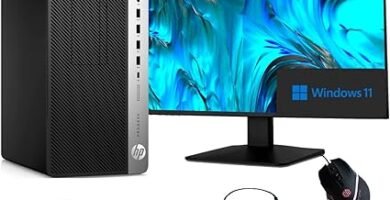
Tips to Keep Your PC in Optimal Condition
Keeping your PC in good shape is key to ensuring its performance and extending its lifespan. Whether you use your computer for work, gaming, or everyday tasks, proper maintenance can prevent costly issues in the long run. Below are some essential tips for taking care of both the hardware and software of your computer.
1. Clean the hardware: Keep your PC dust-free
Dust is one of the main enemies of any computer, as it can accumulate inside the system and affect the performance of fans and the cooling system.
1.1. Regular cleaning
- Frequency: It’s recommended to clean the exterior of your PC every two weeks and to do a deep internal cleaning every 3-6 months.
- Materials: For internal cleaning, use compressed air, anti-static brushes, and microfiber cloths.
- How to clean:
- Power off and unplug the system.
- Open the case (for desktop PCs) and blow compressed air onto the fans, ventilation slots, and internal components to remove dust.
- Wipe surfaces gently with a soft brush or cloth, avoiding too much pressure.
1.2. Care for the keyboard and screen
- Use a soft, dry cloth to clean the screen.
- Avoid eating near the keyboard to prevent crumbs or debris from damaging the circuits.
- You can use compressed air to remove dust and dirt between the keys.
2. Keep your cooling system efficient
Excessive heat is one of the main factors that can damage your computer’s components. Make sure your cooling system is functioning properly to avoid overheating.
2.1. Check the fans
- Ensure that the fans are working properly and aren’t making unusual noises. If a fan seems to be overworking or is noisy, it may be failing and in need of replacement.
- Consider installing additional fans or a liquid cooling system if you use your computer for heat-intensive tasks like gaming or video editing.
2.2. Use your computer on flat surfaces
- Avoid placing your computer on soft surfaces like beds or cushions, as they can block ventilation and increase the risk of overheating.
- For laptops, using cooling pads can help improve airflow.
3. Regularly update your software
Keeping your software up-to-date not only improves performance but also protects you from security vulnerabilities. Here are some best practices:
3.1. Operating system updates
- Both Windows and macOS regularly release security and performance updates. Set your system to update automatically so it’s always protected.
3.2. Drivers
- Make sure the drivers for components like your graphics card, motherboard, and peripherals are up-to-date. Visit the manufacturers’ websites to download the latest versions if needed.
3.3. Software and programs
- Keep the programs you use frequently updated, such as browsers, video editors, or design tools. Keeping your applications current not only improves functionality but also avoids compatibility issues with the operating system.
4. Manage your storage
Managing storage is crucial to prevent your PC from becoming slow and inefficient over time.
4.1. Clean up temporary files and cache
- Use tools like CCleaner or built-in options in your operating system to remove temporary files, cache, and other unnecessary files that take up space on your disk.
4.2. Defragment your hard drive
- If you have a hard disk drive (HDD), defragmenting it regularly will improve performance by reorganizing data more efficiently. If you have a solid-state drive (SSD), this step isn’t necessary, as SSDs work differently and don’t require defragmentation.
4.3. Use cloud storage or external drives
- If your disk is almost full, consider storing large files (such as photos, videos, or backups) on cloud services or an external drive. This not only improves your computer’s performance but also protects your data in case of a system failure.
5. Protect your system from viruses and malware
Malware can severely impact your computer’s performance and even put your personal information at risk. Here are some steps to protect yourself:
5.1. Install good antivirus software
- Having up-to-date antivirus software is crucial for protecting your PC. There are both paid and free options (like Avast, Kaspersky, or Windows Defender) that offer solid protection against viruses and malware.
5.2. Avoid downloading programs from untrusted sources
- Only download software and apps from official websites or trusted stores like the Microsoft Store or the Mac App Store.
5.3. Run regular scans
- Schedule automatic system scans with your antivirus software to identify potential threats before they become major problems.
6. Avoid overloading your PC with unnecessary programs
Your PC’s performance can be affected if you have too many programs running in the background or installed without a real need. Make sure your system is always optimized.
6.1. Uninstall programs you don’t use
- Take inventory of the installed programs and uninstall those you no longer need. This will free up space on your disk and reduce the load on your RAM and processor.
6.2. Disable startup programs
- Many programs launch automatically when you start your computer, slowing down boot time. Use Task Manager in Windows or Activity Monitor in macOS to disable this option for programs you don’t need at startup.
Conclusion
Preventive maintenance of your PC, both in terms of hardware and software, is essential to keep it running smoothly and to extend its lifespan. Regular cleaning, software updates, and protection from malware are key to avoiding major problems in the future. By following these tips, your computer will function well for many years to come.




